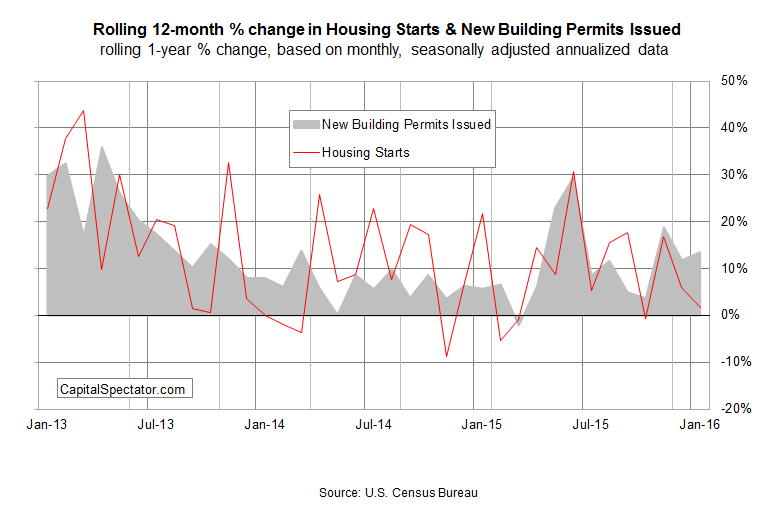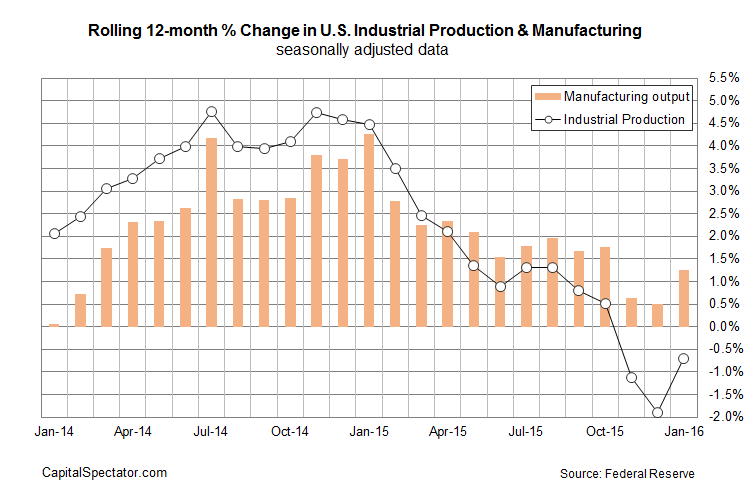One step forward, one step back. Residential construction activity was softer than expected in January while industrial production rocketed skyward after falling in each of the previous three months, according to this morning’s updates from the US Census Bureau and Federal Reserve, respectively. Today’s economic data overall offers a mildly upbeat message. Considered in context with previous releases for January, the data du jour suggests that last month wasn’t the start of a new NBER-defined recession. The near-term outlook is still wobbly, but this morning’s reports hint at the likelihood that the US economy will continue to muddle through the recent rough patch and avoid a new downturn.
Let’s take a closer look at the new numbers, starting with housing starts. Residential construction activity dipped last month, falling to 1.099 million units (seasonally adjusted annual rate)—a three-month low. Economists were looking for a modest increase. The January update weighed on the year-over-year trend, pushing the annual growth rate for starts down to a thin 1.8% increase—the slowest since last October.

Note, however, the newly issued building permits were largely unchanged last month, slipping fractionally vs. the previous month while ticking up to a healthy 13.5% rise vs. the year-earlier level. Considering starts and permits together implies that housing construction will continue to expand a modest pace in the months ahead.
“Seasonal weather and the recent uncertainty in the stock market are likely explanations for the decline in January housing starts,” Bill Banfield, vice president of mortgage provider Quicken Loans tells AP. “Taking a step back to look at year-over-year growth, we continue to see healthy and steady gains.”
Moving on to the industrial sector, today’s update delivered sharply stronger-than-projected results. Output surged 0.9% in January—the biggest monthly gain in five years. But the month-to-month changes are noisy, particularly in recent history, and so it’s necessary to look to the annual pace for a more reliable measure of the trend. There’s some improvement in the latest year-over-year change, but only in the sense that the contraction eased. Industrial output fell 0.7% in January vs. the year-earlier level. Although that’s a relatively modest decline vs. the previous two months, the downturn in annual terms rolls on. Last month marked the third straight month of year-over-year contraction—the longest run of red ink for the annual comparison since the last recession.

On an upbeat note, the manufacturing component for industrial activity is considerably stronger and showing signs of improvement at the kickoff to 2016. Manufacturing activity in January increased 0.5%–the first monthly gain since last October. Even better, the year-over-year increase accelerated last month, rising to 1.2% in January vs. the year-ago level—a three-month high.
“It looks like we’re getting some stabilization,” noted Jacob Oubina, a senior US economist at RBC Capital Markets. “The commodity-related headwinds to manufacturing are seemingly dissipating,” he said via Bloomberg.
Overall, today’s numbers provide a degree of support for arguing that the US economy continued to expand last month. It’s still a precarious expansion, but reviewing the latest data in context with a spectrum of indicators suggests that the National Bureau of Economic Research won’t declare last month as the start of a new US recession.
Attention now turns to the macro profile for February, which is still largely a mystery in terms of the hard data.
Disclosure: Originally published at Saxo Bank TradingFloor.com
